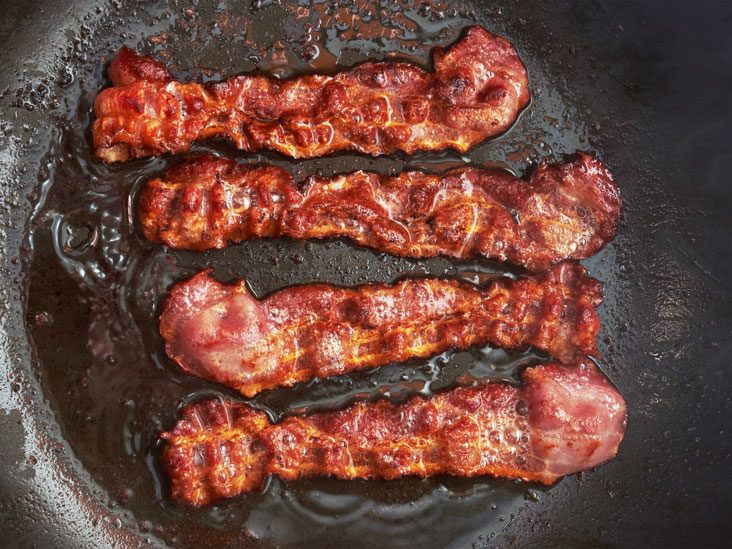What Is Raw Bacon?

Raw bacon refers to bacon that has not been cooked or heated to a safe temperature for consumption. It is typically found in the refrigerated meat section of grocery stores. Raw bacon is made from salt-cured pork belly that has been sliced into thin strips. It contains raw meat and fat, which can potentially harbor harmful bacteria like Salmonella, E. coli, and Listeria. Therefore, it is important to cook bacon thoroughly to ensure food safety and minimize the risk of foodborne illnesses.
Understanding Raw Bacon And Its Potential Risks
Raw bacon is the uncooked form of bacon, made from salt-cured pork belly. While it may be tempting to consume raw bacon, it poses potential risks to your health. Raw bacon contains raw meat and fat, which can harbor harmful bacteria such as Salmonella, E. coli, and Listeria. These bacteria can cause foodborne illnesses, leading to symptoms like nausea, diarrhea, and vomiting. To prevent these risks, it is important to cook bacon thoroughly to ensure food safety. This will help kill any bacteria present and make the bacon safe for consumption.
The Different Types Of Raw Bacon Available
There are several different types of raw bacon available on the market. Some common varieties include:
- Pork Belly Bacon: This is the most traditional and popular type of raw bacon. It is made from the fatty belly of the pig and has a high-fat content, resulting in a rich and flavorful taste.
- Turkey Bacon: This is a leaner alternative to pork bacon, made from turkey meat. It is lower in fat and calories but still offers a similar smoky flavor.
- Beef Bacon: For those who don’t eat pork, beef bacon is a great option. It is made from beef strips and provides a distinct taste and texture.
- Canadian Bacon: Also known as back bacon, Canadian bacon is made from pork loin and is leaner than traditional bacon. It has a milder and slightly sweeter flavor.
It’s important to note that regardless of the type, raw bacon should be cooked thoroughly to ensure food safety and to eliminate any potential risks of consuming raw meat.
Is It Safe To Eat Raw Bacon?

Consuming raw bacon poses significant health risks, and it is not safe to eat it without cooking. Raw bacon may contain harmful bacteria, such as Salmonella or E. coli, which can cause foodborne illnesses. These bacteria can only be eliminated by cooking the bacon thoroughly. Eating raw bacon increases the chances of getting sick and experiencing symptoms like nausea, vomiting, or diarrhea. To ensure your safety, it is essential to cook bacon properly before consumption. Remember, always follow proper cooking guidelines to minimize the risk of foodborne illnesses.
The Potential Dangers Of Consuming Raw Bacon
Consuming raw bacon poses significant health risks due to the potential presence of harmful bacteria, such as Salmonella or E. coli. These bacteria can cause foodborne illnesses and lead to symptoms like nausea, vomiting, and diarrhea. Eating raw bacon increases the chances of getting sick and can have severe consequences, especially for individuals with weakened immune systems. To ensure your safety, it is crucial to cook bacon properly before consumption. Remember, following proper cooking guidelines is essential in minimizing the risk of foodborne illnesses associated with raw bacon.
Factors To Consider Before Eating Raw Bacon
Before consuming raw bacon, there are several important factors to consider. These include:
- Source and quality: Ensure that the bacon comes from a reputable source and is of high quality. Look for bacon that has been properly processed and stored to minimize the risk of bacterial contamination.
- Storage conditions: Raw bacon should be stored properly to prevent the growth of harmful bacteria. Keep it refrigerated at or below 40°F (4°C) and use it within the recommended timeframe.
- Personal health: Individuals with compromised immune systems or certain health conditions, such as pregnancy or HIV/AIDS, are at a higher risk of foodborne illnesses. It is particularly crucial for these individuals to avoid consuming raw bacon.
- Cooking alternatives: Consider alternative cooking methods, such as baking or microwaving, to ensure that bacon is fully cooked and safe to eat.
By considering these factors, individuals can make informed decisions about the safety of consuming raw bacon and minimize the risk of foodborne illnesses.
Can You Cook Bacon Without Cooking It?

While it may sound contradictory, the phrase “cook bacon without cooking it” refers to the idea of preparing bacon using alternative cooking methods that don’t involve traditional stovetop frying or baking. These methods include microwave cooking and air frying. Microwave cooking involves placing the bacon on a microwave-safe plate lined with paper towels and cooking it on high power for a few minutes until crispy. Air frying, on the other hand, involves using an air fryer to circulate hot air around the bacon, resulting in a crispy texture. However, it’s important to note that even though these methods may yield similar results to traditional cooking, the bacon is still being cooked, just in a different way. The main advantage of these methods is that they may be quicker and produce less grease.
Exploring Alternative Cooking Methods For Bacon
When it comes to cooking bacon, there are alternative methods that can be explored to achieve crispy and delicious results. One such method is microwave cooking, where bacon is placed on a microwave-safe plate lined with paper towels and cooked on high power for a few minutes until crispy. Another option is air frying, which involves using an air fryer to circulate hot air around the bacon, resulting in a crispy texture. These methods offer a quicker cooking time and may produce less grease. However, it’s important to note that bacon is still being cooked, just in a different way.
The Safety Implications Of Consuming Partially Cooked Bacon
Eating partially cooked bacon can have safety implications. When bacon is not cooked thoroughly, harmful bacteria like Salmonella and E.coli may still be present, increasing the risk of foodborne illnesses. Partially cooked bacon can also contain parasites like Trichinella, which can cause trichinellosis if ingested. It is essential to cook bacon to the recommended internal temperature of 145°F to ensure that all bacteria and parasites are killed. Consuming partially cooked bacon can lead to symptoms such as nausea, vomiting, diarrhea, and abdominal pain, so it is best to avoid it to prevent any health risks.
Bacon Safety Tips: Storage And Handling

Proper storage and handling of bacon are crucial for ensuring its safety. Here are some important tips to keep in mind:
- Store bacon in the refrigerator at a temperature below 40°F (4°C) to prevent bacterial growth.
- Keep bacon tightly wrapped in its original packaging or in an airtight container to maintain freshness.
- If storing cooked bacon, place it in a separate container to avoid cross-contamination with raw meats.
- Use bacon within 7 days of purchase or freeze it for longer shelf life.
- When handling raw bacon, wash your hands thoroughly before and after to prevent the spread of bacteria.
- Clean cutting boards, utensils, and surfaces that come in contact with raw bacon with hot soapy water to avoid cross-contamination.
Proper Storage Techniques To Prevent Bacterial Growth
To prevent bacterial growth and ensure the safety of bacon, proper storage techniques are essential. Here are a few guidelines to follow:
- Store bacon in the refrigerator at a temperature below 40°F (4°C) to inhibit the growth of bacteria.
- Keep bacon tightly wrapped in its original packaging or transfer it to an airtight container to maintain freshness.
- If storing cooked bacon, place it in a separate container to avoid cross-contamination with raw meats.
- Use bacon within 7 days of purchase or freeze it for longer shelf life.
- When handling raw bacon, remember to wash your hands thoroughly before and after to prevent the spread of bacteria.
- Clean cutting boards, utensils, and surfaces that come in contact with raw bacon with hot soapy water to avoid cross-contamination.
Following these storage and handling practices will help ensure that your bacon stays fresh and safe for consumption.
Tips For Handling And Preparing Raw Bacon Safely
Here are some important tips for handling and preparing raw bacon safely:
- Always wash your hands thoroughly before and after handling raw bacon to prevent the spread of bacteria.
- Use separate cutting boards and utensils for raw bacon to avoid cross-contamination with other foods.
- Keep raw bacon refrigerated until ready to use, and avoid leaving it at room temperature for long periods.
- Cook bacon thoroughly to a minimum internal temperature of 145°F (63°C) to kill any bacteria.
- Dispose of any leftover raw bacon properly to prevent the risk of bacterial growth.
Follow these tips to ensure that you handle and prepare raw bacon safely and minimize the risk of foodborne illness.
Cooking Bacon To Ensure Safety

When it comes to cooking bacon, it is essential to follow a few guidelines to ensure safety and minimize the risk of foodborne illness. Firstly, it is important to cook bacon to the recommended internal temperature of 145°F (63°C) to kill any bacteria. This can be achieved by frying, baking, or grilling the bacon until it is crispy. Additionally, it is crucial to avoid leaving partially cooked bacon at room temperature, as this can promote bacterial growth. By following these cooking practices, you can enjoy bacon safely and without any health concerns.
Recommended Cooking Temperatures For Bacon
Bacon should be cooked to a minimum internal temperature of 145°F (63°C) to ensure safety and kill any potential bacteria. Due to the thinness of bacon slices, it can be challenging to accurately measure its temperature using a meat thermometer. Therefore, it is recommended to cook bacon until it is crispy, as this is an indicator that it has reached the desired temperature. Crispy bacon not only ensures safety but also enhances the flavor and texture of this popular breakfast staple.
How To Properly Cook Bacon To Minimize The Risk Of Foodborne Illness
To properly cook bacon and minimize the risk of foodborne illness, it is important to follow these guidelines:
- Preheat the oven or skillet: Preheat your oven to 400°F (200°C) or your skillet over medium heat.
- Arrange the bacon: Lay the bacon slices in a single layer on a baking sheet or arrange them in the skillet without overlapping.
- Cook until crispy: Cook the bacon until it is golden brown and crispy. This usually takes about 10-15 minutes in the oven or 5-7 minutes in a skillet.
- Drain excess grease: Once cooked, place the bacon on a paper towel-lined plate to drain any excess grease.
- Discard any undercooked or burnt bacon: If any bacon slices appear undercooked or burnt, discard them to ensure safety.
By following these steps, you can properly cook bacon to minimize the risk of foodborne illness and enjoy this delicious treat in a safe manner.
Conclusion

In conclusion, consuming raw bacon poses a significant risk of foodborne illness due to potential bacterial contamination. It is important to cook bacon thoroughly to ensure safety and minimize the risk of harmful pathogens. While it is tempting to enjoy the taste of bacon, it is wise to limit consumption of processed meats like bacon, as they have been linked to various health conditions. By following proper storage, handling, and cooking techniques, you can still enjoy bacon as part of a balanced diet while reducing the risk of foodborne illness.
Final Thoughts On The Safety Of Consuming Raw Bacon
In conclusion, consuming raw bacon poses a significant risk of foodborne illness due to potential bacterial contamination. It is important to cook bacon thoroughly to ensure safety and minimize the risk of harmful pathogens. While it is tempting to enjoy the taste of bacon, it is wise to limit consumption of processed meats like bacon, as they have been linked to various health conditions. By following proper storage, handling, and cooking techniques, you can still enjoy bacon as part of a balanced diet while reducing the risk of foodborne illness.
Important Considerations And Best Practices For Enjoying Bacon Safely
When it comes to enjoying bacon safely, there are a few important considerations and best practices to keep in mind. Here are some tips to ensure the safety of your bacon consumption:
- Purchase bacon from reputable sources: Choose bacon products from trusted brands and suppliers to minimize the risk of contamination.
- Check the expiration date: Always check the package for the expiration date and make sure the bacon is within its safe consumption period.
- Properly store bacon: Keep bacon refrigerated at temperatures below 40°F (4°C) to prevent bacterial growth. Use it within a few days of opening the package.
- Separate raw bacon from other foods: Store raw bacon away from other foods, especially those that will be consumed raw or without further cooking.
- Practice good hygiene: Wash your hands thoroughly before and after handling raw bacon to prevent cross-contamination.
- Cook bacon thoroughly: Use recommended cooking temperatures and cook bacon until it reaches a crispy texture to minimize the risk of foodborne illness.
By following these important considerations and implementing best practices, you can enjoy bacon as part of a balanced diet while reducing the risk of foodborne illnesses.
FAQ about eating raw bacon:
| Can you eat bacon raw? |
|---|
| Eating raw bacon is not recommended due to the risk of foodborne illness. Bacon is a processed meat and may contain harmful bacteria like Salmonella or E. coli that can cause food poisoning if not cooked properly. |
| Why is eating raw bacon risky? |
| Raw bacon can harbor bacteria that can multiply rapidly if not cooked at high enough temperatures to kill them. Consuming undercooked or raw bacon can lead to symptoms like nausea, vomiting, diarrhea, and fever. |
| How should bacon be cooked to be safe to eat? |
| Bacon should be cooked until it reaches an internal temperature of 145°F (63°C) to ensure that harmful bacteria are killed. It is best to fry, bake, or grill bacon until it is crispy and browned. |
| Can you eat bacon that is slightly undercooked? |
| It is not recommended to eat undercooked bacon. Consuming bacon that is not thoroughly cooked can still pose a risk of foodborne illness. It’s best to err on the side of caution and cook bacon until it is fully done. |
| Are there any safe alternatives to eating raw bacon? |
| If you enjoy the flavor of bacon but prefer not to eat it raw, you can try using cooked bacon bits or bacon crumbles as toppings for salads, soups, or other dishes. Make sure to cook the bacon until it is fully done before using it in recipes. |

Halal Meat Bazar is a leading provider of HMC-approved quality halal meat, offering competitive prices and exceptional services. With a commitment to excellence, we cater to both wholesale and retail customers, ensuring that everyone has access to premium halal meat products. Our journey began with a passion for providing the finest quality halal meat to the community. Founded on the principles of integrity and quality, Halal Meat Bazar has consistently upheld the highest standards in sourcing, processing, and delivering halal meat products. Our dedication to maintaining the authenticity of halal meat has earned us the trust and loyalty of our customers.